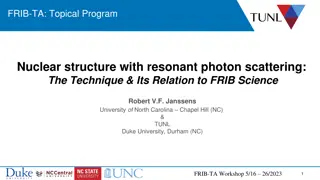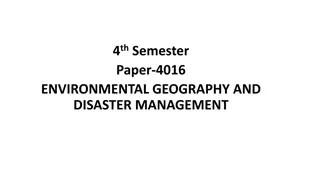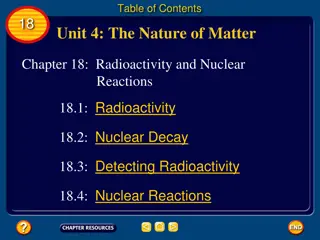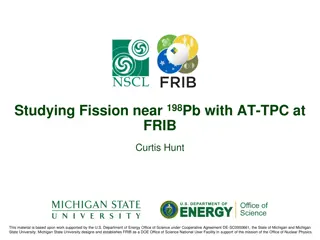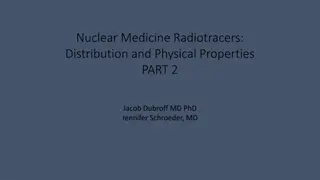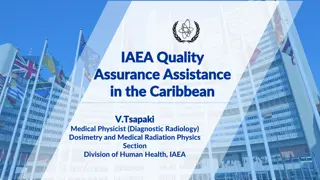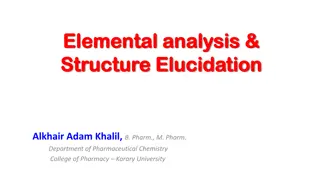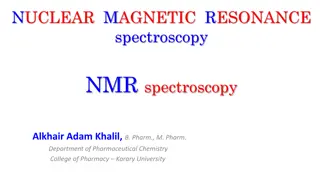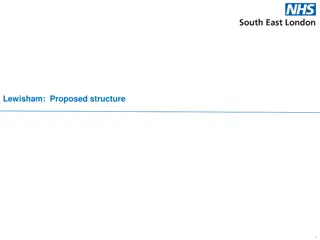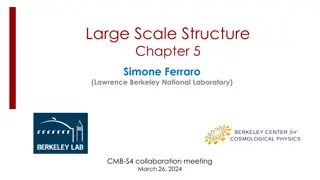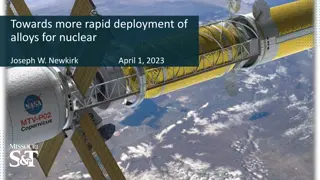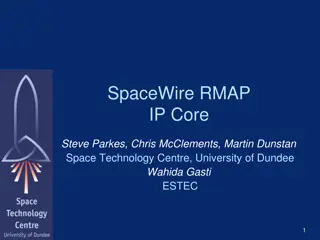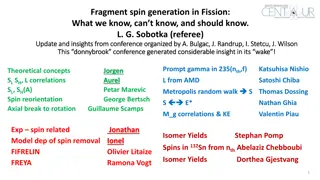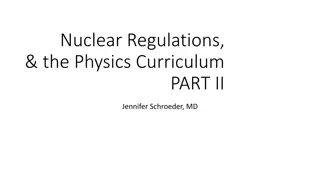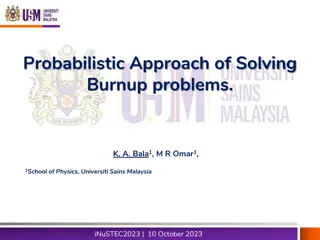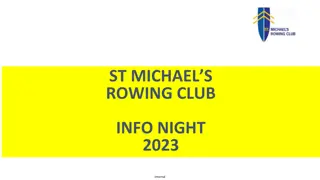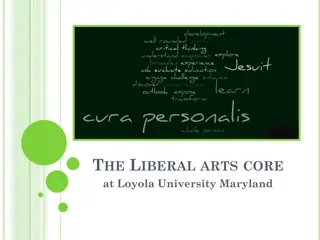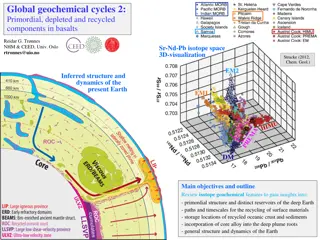Insights into Nuclear Core Dynamics and Structure
Exploring the dynamics of nuclear cores, this research delves into the intricacies of probing the NN repulsive core, modern NN potentials, and field theories of nucleons and mesons. The study encompasses the isospin dependence, non-nucleonic components, hidden color, and gluons within the nucleus, shedding light on the nature of the core in relation to various processes. Additionally, it discusses the stability of nuclei in relation to attractive and repulsive forces, as well as the significance of NN potentials in understanding nuclear density saturation.
Download Presentation
Please find below an Image/Link to download the presentation.
The content on the website is provided AS IS for your information and personal use only. It may not be sold, licensed, or shared on other websites without obtaining consent from the author. Download presentation by click this link. If you encounter any issues during the download, it is possible that the publisher has removed the file from their server.
Presentation Transcript
QCD Dynamics of Nuclear Core Misak Sargsian Florida International University, Miami Short Distance Nuclear Structure and PDFs, ECT*, Trento J uly 17-21th, 2023
Probing NN Repulsive Core - strength of the core; - isospin dependence of repulsive core - non-nucleonic components, hidden color, gluons - dependence of the nature of the core to the nature of the process
Probing NN Repulsive Core - NN force is attractive: But Nuclei are Stable If the two-body forces are everywhere attractive and if many-body forces are neglected then the nucleon pairs are sufficiently close to take advantage of attractive interactions and a collapsed state of nuclear matter results G. Breit and E.P. Wigner, Phys. Rev. 53, 998 (1938). Many body forces keeping nucleus stable J astrow 1951 assumed the existence of the infinite hard core to explain the angular distribution of pp cross section at 340 MeV (r0=0.6fm) Non-monotonic NN central potential with the repulsive core was introduced: Brueckner & Watson 1953 to obtain nuclear density saturation.
Modern NN Potentials 60 s
150 V, MeV 100 50 0 -50 -100 -150 0 0.5 1 1.5 2 2.5 3 3.5 4 4.5 r,fm NN potential Vc, MeV 15000 10000 5000 0.2 0.4 0.6 0.8 r, Fm
Pomeranchuk, Landau - 1950's Infinite interaction occurs at transferred momenta approx 500 MeV/c or at internucleon distances 1~Fm. It seems we have a problem about which the Nature is not aware of Y.Pomeranchuk All formal quantum field theories with Yukawa type interactions contain the problem of the ``Zero Charge' Pomeranchuk, Sudakov, Ter-Martirosyan, Phys. Rev. 1956
Lattice Calculations VC(r) [MeV] 0 100 200 300 400 500 600 0.0 -50 0 50 100 0.5 0.0 0.5 1.0 r [fm] 1.0 OPEP 1.5 3S1 1S0 1.5 2.0 2.0
QCD 15000 10000 5000 Pauli Blocking 0.2 0.4 0.6 0.8 Contradicts Neutron Star Observations: will predict masses not more than 0.1 - 0.6 Solar mass
QCD Vc, MeV 15000 Intrinsic strangeness/charm Hidden Color 10000 5000 0.2 0.4 0.6 0.8 r ~80% hidden color Brodsky,Ji, Lepage, PRL 83
Quasi-Elastic Scattering Vc, MeV 15000 pn 10000 pn 5000 Hidden Color 0.2 0.4 0.6 0.8 r
Probing the Deuteron at Short Distances The NN core can be due to the orthogonality of
Vc, MeV 15000 pn 10000 pn 5000 Hidden Color 0.2 0.4 0.6 0.8 r
Conceptually: How to probe nuclei at such a short nucleon separations - probe bound nucleons at large internal momenta >300MeV/c - considering quasielastic - several novel observations: E. Piasetzky, MS, L. Frankfurt, M. Strikman, J.Watson, PRL , 2006 MS,arXiv:1210.3280 (2012), Phys. Rev. C 2014 JLab produced 2 Science and 1 Nature papers |pmin|, GeV/c 1.4 Q2 = 10 GeV2 1.2 Limitations 1 0.8 0.6 - to probe larger internal momenta larger Q2 is needed 0.4 0.2 Q2 = 0.5 GeV2 0 0 0.25 0.5 0.75 1 1.25 1.5 1.75 2 x
To Summarize. - are being currently investigated in quasielastic channel - needs significantly larger Q2 or missing momenta - Alternative approach is to explore nuclear Deep Inelastic Scattering at x>1
SuperFast quarks short distance probes in nuclei Two factors driving nucleons close together Dynamical: QCD evolution Kinematic 2 2 Q = 10 (GeV/c) , x=1 -0 [GeV/c] initial p 2 2 Q = 10 (GeV/c) , x=1.5 2 2 Q = 15 (GeV/c) , x=1 -0.2 2 2 Q = 15 (GeV/c) , x=1.5 -0.4 -0.6 -0.8 -1 -1.2 -1.4 -1.6 -1.8 1 1.5 2 2.5 3 W [GeV]
Light Cone Approximation ds/dEedW (nb/GeV/sr) 103 Ei = 4.045 GeV, qe= 150 102 10 Ei = 9.744 Gev, qe= 100 1 -1 10 -2 10 Ei = 4.045 GeV, qe= 300 -3 10 -4 10 0.4 0.6 0.8 1 1.2 1.4 1.6 1.8 2 x
10 1 xB = 0.55 (i = 0) xB = 0.65 10 3 (i = 1) xB = 0.75 (i = 2) 10 5 xB = 0.85 F2(xB,Q2) 10 ix (i = 3) xB = 0.95 10 7 (i = 4) xB = 1.05 10 9 (i = 5) xB = 1.15 (i = 6) 10 11 xB = 1.25 New Fit This work F-A fit JLab BCDMS SLAC CCFR (i = 7) 101 102 Q2(Ge V2)
1. Convolution Model X d N
2. Quark-Cluster - 6q - Model + - + + + T T T Gunion, Nason, Blankenbecler, PRD 1984 T d T Carlson, Lassila, Sukhatme, PLB 1988,1991
Reference Frame Defining light-cone four- momenta: Pseudo-CM Reference Frame:







